Fiches poissons d'eau douce (page 25)
Page 25 des 1910 espèces de poissons d'eau douce avec 60 fiches. Il y a 22 genres différents de Pectenocypris à Poecilia.
Liste des fiches de Pectenocypris korthausae à Poecilia caucana
- Pectenocypris korthausae

3,0 → 3,5 cm (> 50 L)
pH 5,0–6,5 | GH 1–5 | 24–28°C - Pelvicachromis drachenfelsi

5,0 → 7,0 cm (> 80 L)
pH 6,0–7,0 | GH 3–12 | 23–28°C - Pelvicachromis kribensis

7,0 → 9,0 cm (> 120 L)
pH 6,0–7,5 | GH 1–15 | 22–26°C - Pelvicachromis pulcher
 Pelmato
Pelmato
8,0 → 10,0 cm (> 120 L)
pH 5,0–6,5 | GH 1–10 | 24–29°C - Pelvicachromis roloffi

6,0 → 8,5 cm (> 80 L)
pH 5,0–6,5 | GH 1–5 | 25–28°C - Pelvicachromis sacrimontis
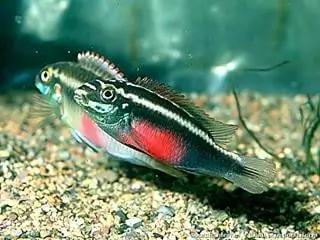 Pelmato vert, Kribensis géant
Pelmato vert, Kribensis géant
8,0 → 10,0 cm (> 120 L)
pH 5,5–7,0 | GH 1–10 | 22–27°C
- Pelvicachromis silviae
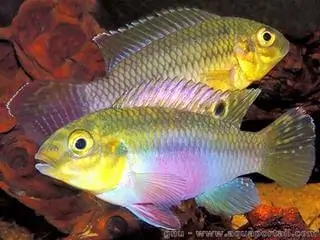
3,5 → 5,0 cm (> 50 L)
pH 5,0–7,0 | GH 1–8 | 24–27°C - Pelvicachromis subocellatus
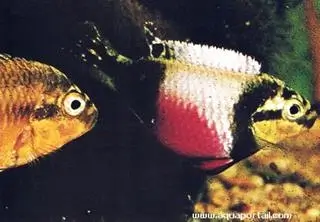
8,0 → 10,0 cm (> 120 L)
pH 6,0–7,5 | GH 1–15 | 22–27°C - Pelvicachromis taeniatus
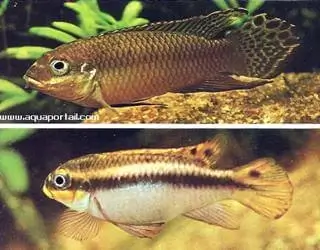
7,0 → 9,0 cm (> 120 L)
pH 6,0–7,5 | GH 1–15 | 22–27°C - Perca fluviatilis
 Perche commune, Perche fluviatile, Perche royale, Perche européenne
Perche commune, Perche fluviatile, Perche royale, Perche européenne
30,0 → 50,0 cm (> 1500 L)
pH 6,0–7,5 | GH 5–20 | 6–22°C - Periophthalmus barbarus
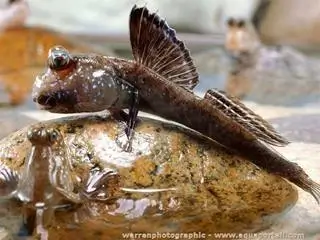 Périophthalme, Sauteur de vase Atlantique
Périophthalme, Sauteur de vase Atlantique
12,0 → 20,0 cm (> 200 L)
pH 7,5–8,5 | GH 10–30 | 25–30°C - Periophthalmus modestus
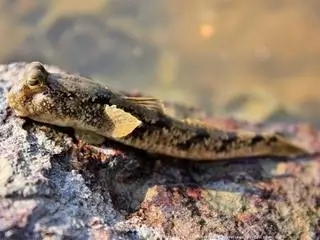 Poisson navette
Poisson navette
8,0 → 10,0 cm (> 120 L)
pH 7,5–8,5 | GH 10–30 | 23–27°C - Petenia splendida

40,0 → 50,0 cm (> 1500 L)
pH 7,0–7,5 | GH 8–15 | 26–30°C - Pethia aurea
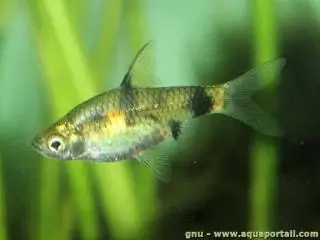
2,0 → 3,0 cm (> 50 L)
pH 6,0–7,0 | GH 3–12 | 18–24°C - Pethia conchonius
 Barbus rosé
Barbus rosé
12,0 → 15,0 cm (> 450 L)
pH 6,0–7,5 | GH 1–15 | 18–25°C - Pethia expletiforis
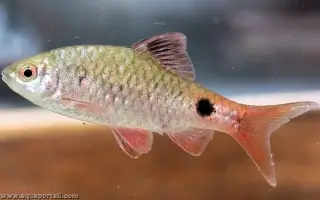
4,0 → 4,7 cm (> 80 L)
pH 6,0–7,0 | GH 3–12 | 22–25°C - Pethia gelius
 Barbus à taches, barbus doré
Barbus à taches, barbus doré
4,0 → 5,2 cm (> 80 L)
pH 6,0–7,5 | GH 5–12 | 18–25°C - Pethia manipurensis
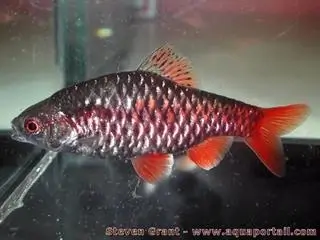
5,8 → 6,2 cm (> 80 L)
pH 6,0–7,5 | GH 3–12 | 22–27°C - Pethia nigripinna

3,5 → 4,5 cm (> 80 L)
pH 6,5–7,5 | GH 5–12 | 23–27°C - Pethia nigrofasciata
 Barbus à tête pourpre
Barbus à tête pourpre
6,0 → 7,0 cm (> 120 L)
pH 6,0–7,0 | GH 5–12 | 22–26°C - Pethia padamya
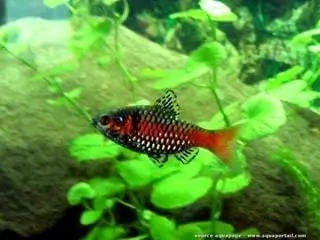 Barbus odessa
Barbus odessa
4,5 → 5,0 cm (> 120 L)
pH 5,0–7,0 | GH 1–12 | 23–27°C - Pethia stoliczkana

4,5 → 5,5 cm (> 80 L)
pH 6,0–7,5 | GH 5–12 | 23–27°C - Pethia ticto

5,5 → 6,5 cm (> 80 L)
pH 6,0–7,5 | GH 3–10 | 18–25°C - Petitella georgiae
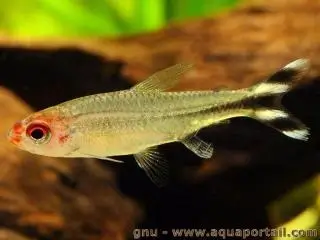 Faux nez-rouge
Faux nez-rouge
4,5 → 5,5 cm (> 80 L)
pH 6,0–7,0 | GH 1–8 | 22–26°C
- Petrochromis fasciolatus

12,0 → 15,0 cm (> 450 L)
pH 7,5–8,5 | GH 10–20 | 23–27°C - Petrochromis horii

12,0 → 15,0 cm (> 450 L)
pH 7,5–8,5 | GH 10–30 | 23–27°C - Petrochromis trewavasae

14,0 → 18,0 cm (> 800 L)
pH 7,5–8,5 | GH 10–20 | 23–25°C - Petrotilapia flaviventris
 Tilapia à ventre jaune
Tilapia à ventre jaune
10,0 → 12,0 cm (> 450 L)
pH 8,0–9,0 | GH 10–25 | 24–26°C - Petrotilapia mumboensis

13,0 → 16,0 cm (> 300 L)
pH 7,5–8,5 | GH 10–25 | 23–27°C - Petrotilapia palingnathos

11,0 → 13,0 cm (> 450 L)
pH 8,0–9,0 | GH 10–25 | 24–26°C - Petrotilapia pyroscelos
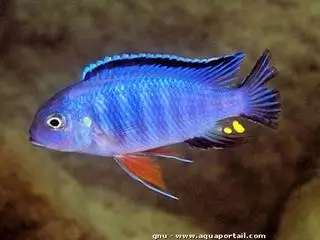
10,0 → 15,0 cm (> 200 L)
pH 7,5–8,5 | GH 10–25 | 23–27°C - Petrotilapia tridentiger

14,0 → 17,0 cm (> 800 L)
pH 8,0–9,0 | GH 10–25 | 24–26°C - Petrotilapia xanthos
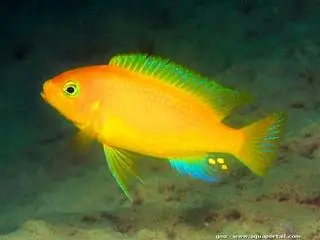
11,0 → 13,0 cm (> 200 L)
pH 7,5–8,5 | GH 10–25 | 23–27°C - Phago loricatus
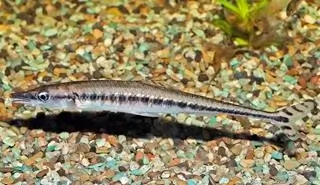
14,0 → 17,0 cm (> 300 L)
pH 5,5–7,5 | GH 1–12 | 20–29°C - Phalloceros caudimaculatus

3,5 → 6,0 cm (> 80 L)
pH 7,0–8,0 | GH 10–20 | 20–25°C - Phenacogrammus aurantiacus

9,0 → 11,0 cm (> 200 L)
pH 5,0–7,0 | GH 3–12 | 22–28°C - Phenacogrammus bleheri

5,5 → 6,5 cm (> 120 L)
pH 5,5–7,0 | GH 3–10 | 23–28°C - Phenacogrammus interruptus
 Tétra du Congo, Phénaco
Tétra du Congo, Phénaco
6,0 → 10,0 cm (> 200 L)
pH 5,0–7,5 | GH 3–12 | 23–27°C - Phenacogrammus major

7,0 → 9,5 cm (> 200 L)
pH 6,0–7,0 | GH 3–10 | 22–26°C - Phenacostethus smithi
 Poisson priapium de Smith
Poisson priapium de Smith
1,8 → 2,0 cm (> 20 L)
pH 7,0–8,5 | GH 10–30 | 23–27°C - Phractocephalus hemioliopterus
 Poisson-chat à queue rouge, Cajaro, Pirarara
Poisson-chat à queue rouge, Cajaro, Pirarara
60,0 → 135,0 cm (> 6000 L)
pH 5,5–7,0 | GH 3–10 | 20–30°C - Physoschistura chulabhornae
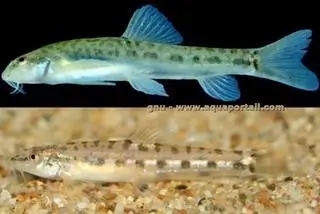
5,0 → 6,0 cm (> 120 L)
pH 6,0–7,0 | GH 3–10 | 23–26°C - Pimelodus albicans
 Bagre blanc
Bagre blanc
45,0 → 57,0 cm (> 1500 L)
pH 6,5–7,5 | GH 3–15 | 20–25°C - Pimelodus blochii
 Bagre pimélode
Bagre pimélode
20,0 → 35,0 cm (> 800 L)
pH 6,0–7,5 | GH 3–10 | 20–26°C - Pimelodus maculatus
 Bagre jaune
Bagre jaune
36,0 → 51,0 cm (> 1500 L)
pH 6,5–7,5 | GH 3–15 | 20–24°C - Pimelodus pictus
 Bagre décoré
Bagre décoré
9,0 → 11,0 cm (> 200 L)
pH 6,0–7,5 | GH 3–15 | 21–25°C - Pimelodus tetramerus
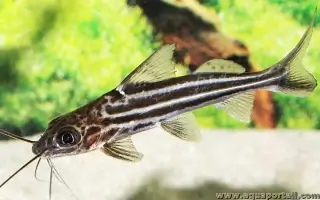 Bagre à 4 lignes
Bagre à 4 lignes
14,0 → 18,0 cm (> 450 L)
pH 6,0–7,5 | GH 5–12 | 21–26°C - Pimephales notatus
 Méné ventre-pourri, méné à museau arrondi
Méné ventre-pourri, méné à museau arrondi
6,0 → 11,0 cm (> 200 L)
pH 6,0–7,5 | GH 3–12 | 0–33°C - Pimephales promelas
 Tête-de-boule
Tête-de-boule
7,0 → 11,0 cm (> 200 L)
pH 6,5–7,5 | GH 5–15 | 10–21°C - Placidochromis electra

12,0 → 17,0 cm (> 450 L)
pH 7,5–8,5 | GH 10–30 | 24–26°C - Planiloricaria cryptodon

18,0 → 22,0 cm (> 450 L)
pH 6,0–7,5 | GH 3–8 | 22–28°C - Plataplochilus oslislyensis

5,0 → 5,5 cm (> 80 L)
pH 7,0–8,0 | GH 10–30 | 20–25°C - Plataplochilus terveri

3,5 → 4,5 cm (> 120 L)
pH 6,5–7,5 | GH 5–12 | 18–22°C - Platydoras armatulus
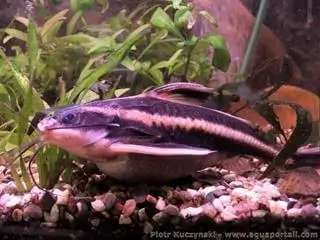 Silure rayé de Raphaël
Silure rayé de Raphaël
16,0 → 20,0 cm (> 300 L)
pH 5,5–7,5 | GH 2–20 | 23–29°C - Platydoras costatus
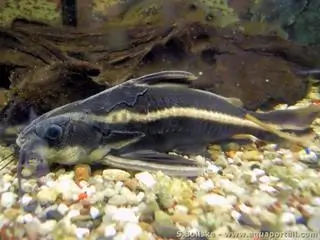 Silure rayé
Silure rayé
20,0 → 24,0 cm (> 300 L)
pH 5,5–7,0 | GH 3–15 | 24–30°C - Platydoras hancockii
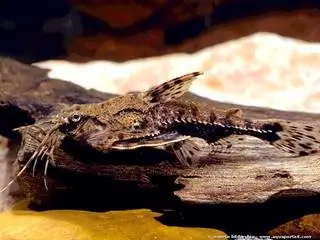 Poisson-chat aux yeux bleus, Doras d'Hancock
Poisson-chat aux yeux bleus, Doras d'Hancock
12,0 → 16,0 cm (> 200 L)
pH 6,0–8,0 | GH 5–20 | 23–28°C - Poecilia amazonica
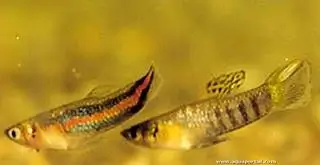
2,5 → 4,0 cm (> 20 L)
pH 7,0–7,5 | GH 5–10 | 24–28°C - Poecilia boesemani
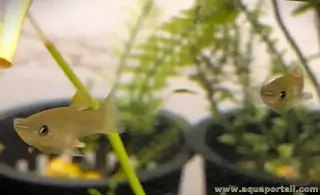
3,0 → 4,0 cm (> 80 L)
pH 7,0–7,5 | GH 8–15 | 24–28°C - Poecilia butleri
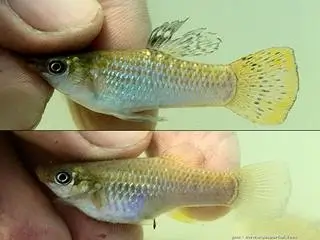 Molly pacifique
Molly pacifique
7,0 → 8,0 cm (> 200 L)
pH 7,0–8,0 | GH 5–20 | 23–27°C - Poecilia caucana
 Molly de Cauca
Molly de Cauca
3,0 → 6,0 cm (> 50 L)
pH 7,0–7,5 | GH 8–20 | 26–30°C
Les données biologiques des espèces indiquent la taille en cm et, si les valeurs sont pertinentes, d'autres caractéristiques spécifiques.
